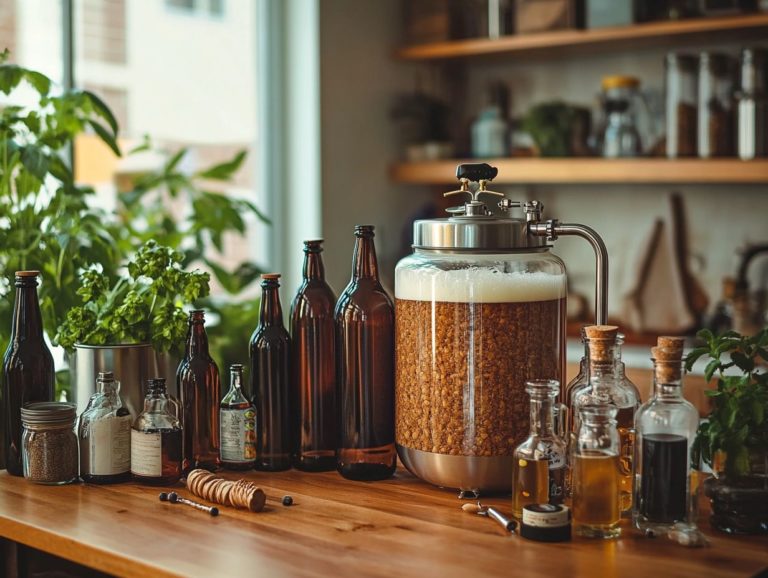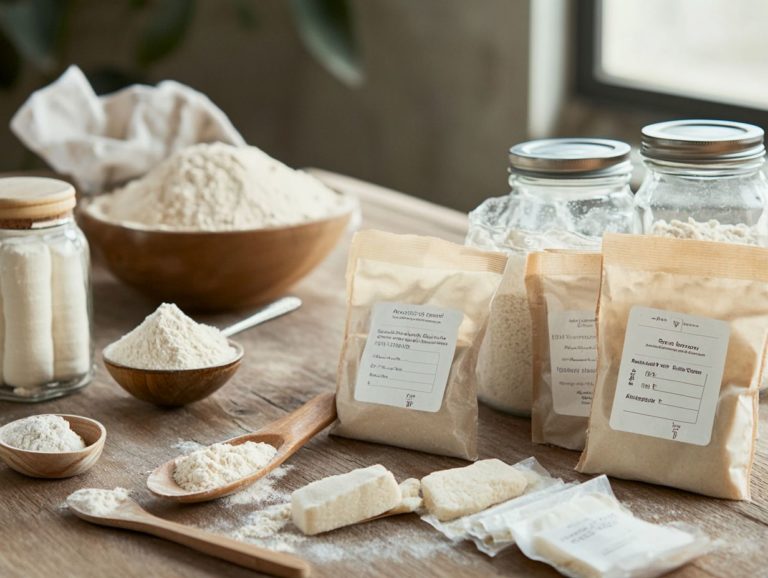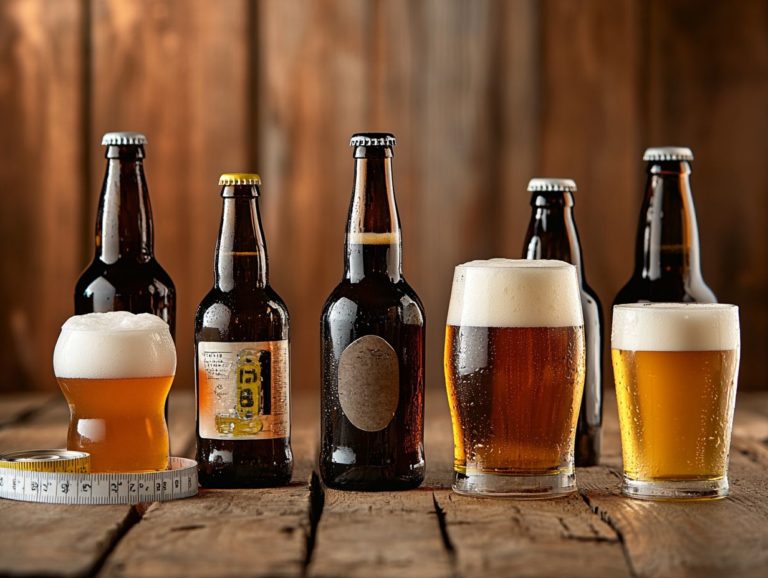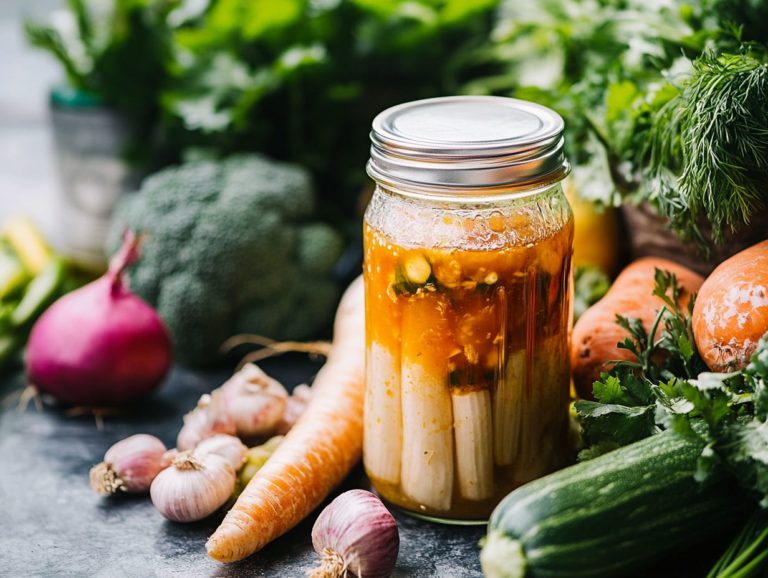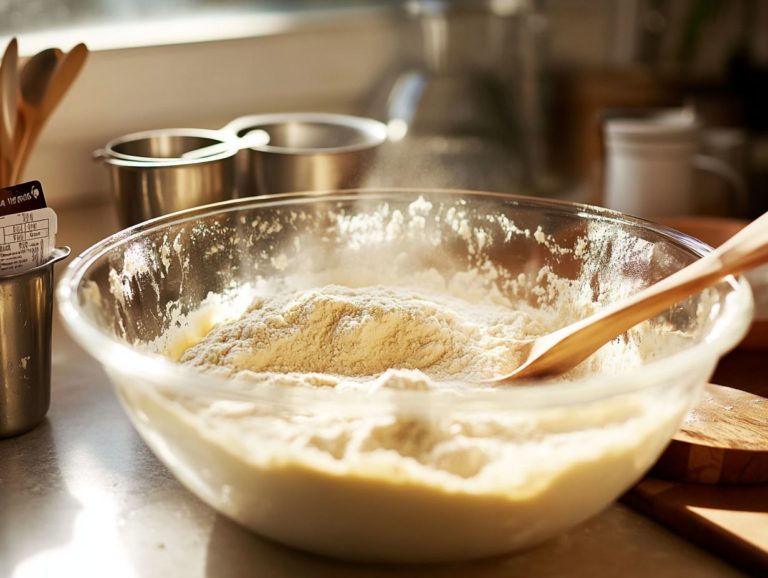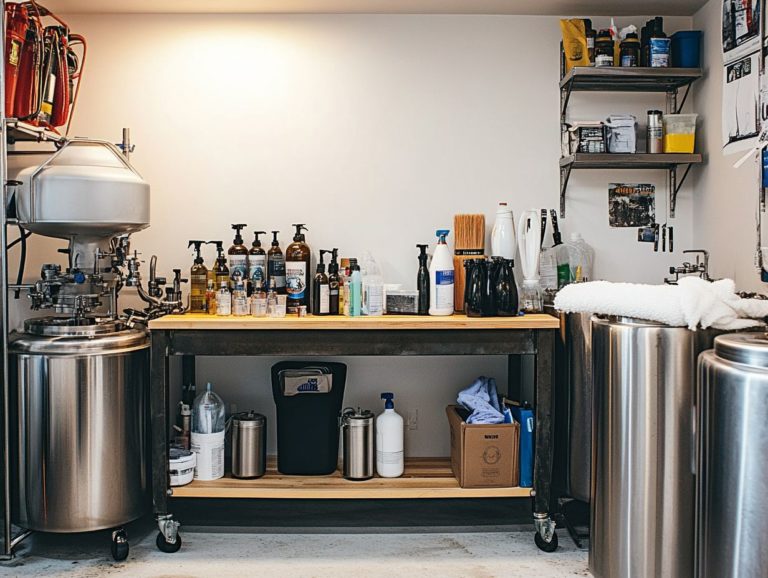Can I Brew Beer at Home Legally?
Homebrewing, a form of domestic brewing, has emerged as a cherished pastime for many. Before you embark on the journey of crafting your own alcoholic beverages, it s crucial to grasp the legal landscape surrounding this hobby.
This article delves into the laws governing homebrewing, highlighting the numerous benefits of brewing your own beer and assessing whether it can indeed save you some money.
You ll find insights on the essential equipment and ingredients required, accompanied by a detailed step-by-step guide to assist you in brewing your very first batch.
Whether you seek a delightful hobby or an inspiring creative outlet, you’ll find everything you need to start brewing today!
Contents
- Key Takeaways:
- Is It Legal to Brew Beer at Home?
- What Are the Benefits of Homebrewing?
- Is It Cheaper to Brew Beer at Home?
- Can You Customize Your Beer When Homebrewing?
- Is Homebrewing a Fun Hobby?
- What Equipment Do You Need to Brew Beer at Home?
- What Are the Steps for Brewing Beer at Home?
- Frequently Asked Questions
- Can I brew beer at home legally in the United States?
- Do I need a license to brew beer at home?
- Are there any age restrictions for homebrewing?
- Can I brew any type of beer at home? Understanding beer production limits
- Can I share my homebrewed beer with others? Insights into social gatherings and homebrew events
- Are There Any Safety Regulations for Homebrewing?
Key Takeaways:
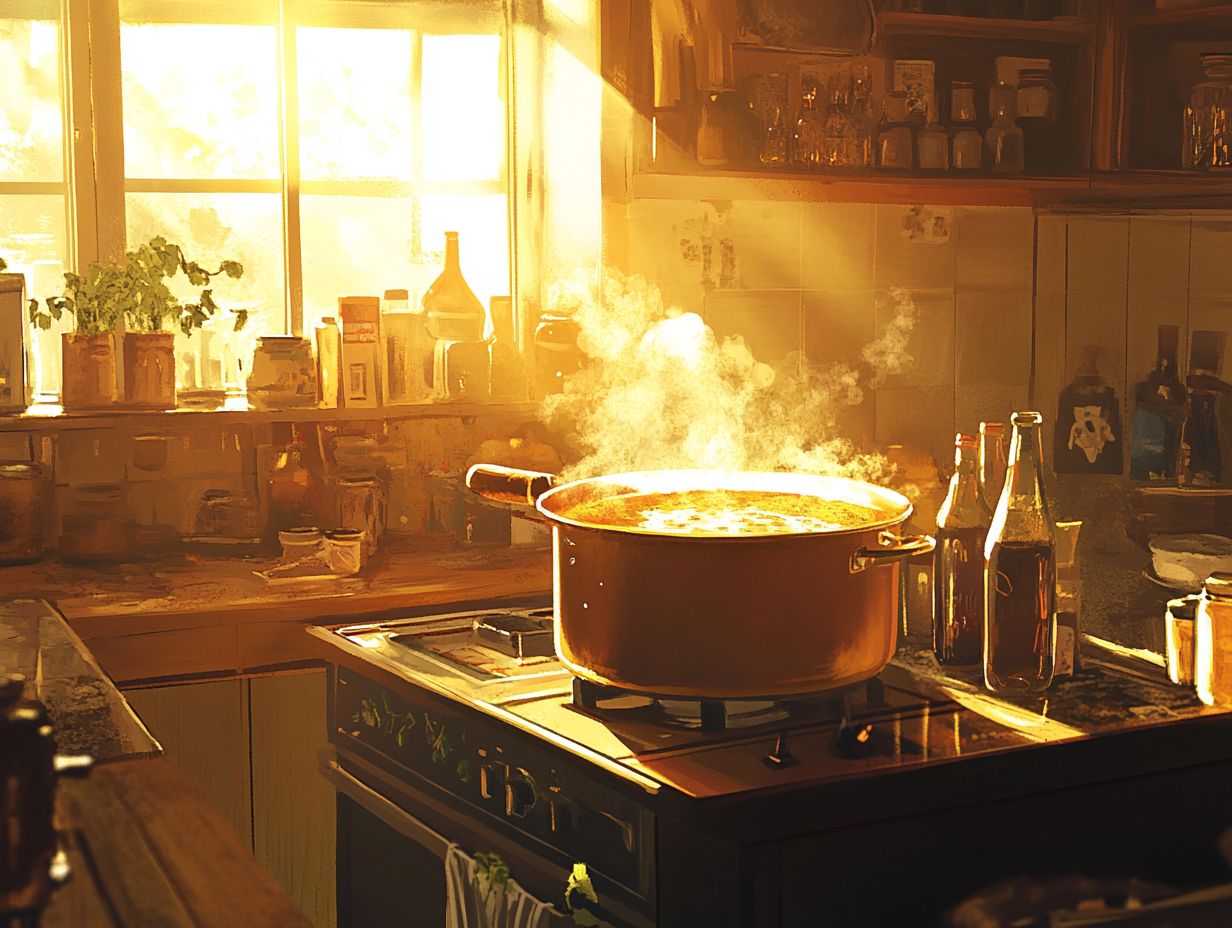
- It is legal to brew beer at home in the United States, as long as certain laws and regulations are followed.
- Homebrewing can be a cost-effective way to enjoy delicious and customized beer. It is also a fun and rewarding hobby that fosters a vibrant community.
- Essential equipment and ingredients, such as a fermenter and malt extract, are needed to successfully brew beer at home. There are also optional tools, like temperature control devices and kegging systems, that can enhance the process.
Is It Legal to Brew Beer at Home?
In the United States, the legal landscape of homebrewing has undergone considerable evolution, particularly after the repeal of Prohibition by the 21st Amendment. This amendment granted individuals the right to brew their own beer at home for personal enjoyment.
However, the set of rules surrounding homebrewing remains intricate and multifaceted. Homebrewing laws and alcohol production regulations vary significantly from state to state. This creates a complex web of regulations that you must skillfully navigate to ensure compliance with both federal and state guidelines.
What Are the Laws Surrounding Homebrewing?
The laws surrounding homebrewing can be quite complex, with regulations that differ at both the federal level and from state to state. For instance, some states allow you to produce up to 100 gallons annually for personal use without any licensing, while others impose strict limits or require permits.
Age restrictions typically dictate that only those aged 21 and older may brew or possess beer. However, some areas allow minors to participate under supervision.
Organizations like the American Homebrewers Association and the Brewers Association are invaluable allies in your journey. They provide resources and guidelines on state-specific laws to keep you informed and compliant. Books like “The Complete Joy of Home Brewing” provide comprehensive insights and practical tips, empowering both new and seasoned brewers to craft unique beers while adhering to legal requirements.
What Are the Benefits of Homebrewing?
Homebrewing offers a wealth of benefits that extend beyond the simple pleasure of crafting your own alcoholic beverages. It ignites your creativity, cultivates a sense of community among fellow enthusiasts, and invites you to explore a diverse array of beer styles and brewing recipes tailored to your unique palate. Additionally, it allows you to transport your homebrew to events and competitions, fostering a deeper connection with the homebrewing culture.
Is It Cheaper to Brew Beer at Home?
One of the most common questions you might have about homebrewing is whether it s actually cheaper to brew your own beer rather than buying commercial alcoholic beverages. Many enthusiasts like you want to grasp not only the money matters but also the rich history and brewing techniques behind brewing. While the initial investment in a quality brewing kit can set you back anywhere from $100 to $300 covering everything from fermentation tanks to essential equipment the long-term savings can be quite impressive.
For example, brewing a five-gallon batch at home could cost you around $40 to $60 when you factor in ingredients like malt, hops, and yeast. In comparison, grabbing a six-pack of craft beer can easily run you $10 to $15. So, if you find yourself reaching for craft beer regularly, brewing at home can lead to significant savings over time.
As you increase your batch sizes, the cost per unit of your homemade beer continues to decrease, turning homebrewing into an increasingly economical choice for devoted beer enthusiasts like yourself.
Can You Customize Your Beer When Homebrewing?
One of the most exhilarating aspects of homebrewing lies in your ability to customize your beer, allowing you to experiment with a variety of brewing recipes and styles to craft unique flavors that cater to your personal preferences. Grasping the ingredients involved in brewing is essential, as each element can dramatically shape the final taste and aroma of your creation.
For example, your choice of malt can introduce sweet, roasted, or caramel notes, while specific hop varieties may add floral, bitter, or citrusy sensations. Popular beer styles like IPAs, stouts, and lagers exemplify how these ingredients can combine in diverse ways to produce distinct flavor profiles.
Fermentation tanks are critical in this customization journey, granting you control over temperature and yeast interaction, which significantly influences the fermentation process and, in turn, the complexity of the beer. By mastering these fundamental elements, you can truly develop a signature brew that encapsulates your individual taste.
Is Homebrewing a Fun Hobby?
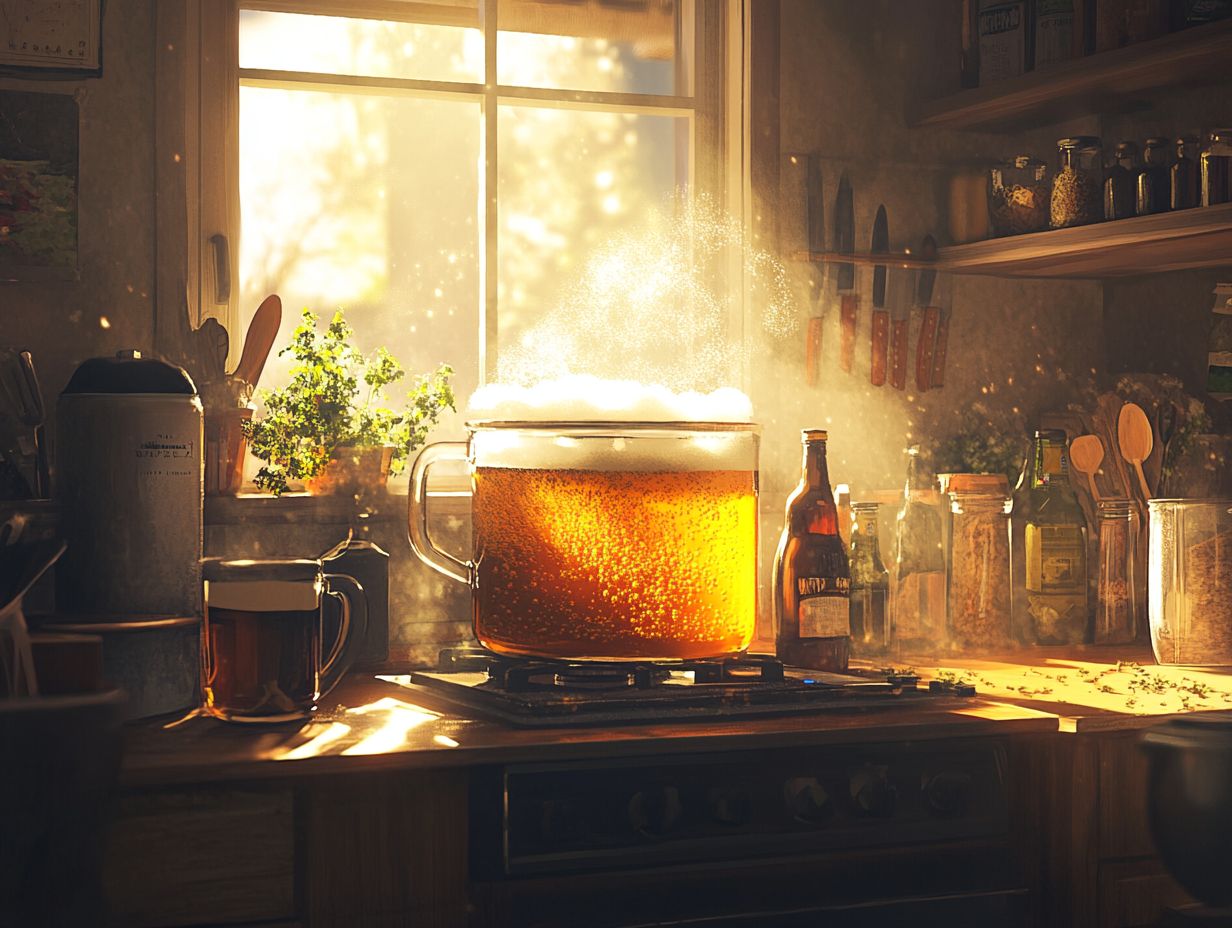
Is there anything more rewarding than brewing your own beer? Homebrewing stands out as a delightful and fulfilling hobby, immersing you in the brewing process while nurturing a vibrant culture that celebrates creativity and community through various homebrew events and local competitions.
As you delve into the world of brewing, you ll experience the sheer joy of experimenting with a wide array of recipes, flavors, and techniques, allowing you to craft creations tailored perfectly to your personal taste. This hands-on approach not only instills a sense of accomplishment but also serves as a fantastic conversation starter during social gatherings and homebrew clubs.
Imagine friends gathering around to sample your latest batches and share their thoughts, turning ordinary get-togethers into unforgettable moments. Engaging in local competitions and homebrew competitions offers an excellent avenue for you to showcase your craft and connect with fellow enthusiasts who share your passion, fostering a spirit of camaraderie that enriches the entire brewing community.
What Equipment Do You Need to Brew Beer at Home?
As you embark on the journey of homebrewing, equipping yourself with the right brewing tools is essential for a successful experience. This enables you to efficiently manage the brewing process and produce high-quality beer, all while respecting the production limits set by local regulations, which may include restrictions on the amount of beer you can brew for personal use.
Ready to brew your first batch? Grab your kit and let the adventure begin!
What Are the Essential Pieces of Equipment?
Essential pieces of brewing equipment for you as a homebrewer include fermentation tanks, brewing kits, and sanitation supplies. These are crucial for ensuring a successful and hygienic brewing process. Understanding alcohol legislation and local regulations is also vital.
These tools help you craft quality beer. They also make brewing easier. For instance, fermentation tanks are containers where yeast turns sugar into alcohol, creating the controlled environment necessary for yeast to thrive. This process ultimately influences the flavor and alcohol content of your brew.
Brewing kits equip new brewers with all the essential components, simplifying the initial setup. This makes the process far less intimidating. Meanwhile, sanitation supplies are vital for preventing contamination that could ruin an entire batch.
As a beginner, investing in high-quality tools is a wise move. They enhance the quality of your final product and elevate your brewing experience by minimizing potential pitfalls along the way.
Are There Any Optional Equipment That Can Enhance the Process?
Optional equipment can truly elevate your homebrewing experience. It offers you the chance to refine your techniques and explore a variety of brewing recipes that help you achieve your desired flavors and qualities.
Take temperature control devices, for example. They allow you to maintain consistent fermentation temperatures, which is essential for the health and performance of your yeast. By avoiding pesky temperature fluctuations, you can minimize off-flavors and enhance the complexity of your beers.
Let s not forget about kegging systems. They simplify the process of storing and serving your beer while keeping carbonation levels just right. This ensures a fresher taste with every pour.
Specialty brewing tools, like refractometers and hydrometers, give you precise measurements of sugar content and specific gravity. This allows for even greater refinement in your brewing process.
All these enhancements boost fermentation, leading to richer aromas and improved beer quality that will impress both new and seasoned brewers!
What Ingredients Do You Need for Homebrewing?
To successfully brew beer at home, you need to grasp the essential ingredients that play a pivotal role in the brewing process. These include malted grains, hops, yeast, and water. Together, they form the foundation of a myriad of brewing recipes tailored to various beer styles.
Understanding these components will empower you to craft exceptional brews that reflect your personal taste and preferences.
What Are the Main Ingredients in Beer?
The main ingredients in beer malted grains, hops, yeast, and water each play a pivotal role in the brewing process. They significantly influence the flavor and aroma of the final product. Understanding these components is key to mastering various brewing techniques and creating exceptional brews.
Malted grains, primarily barley, serve as the foundation of beer. They provide the fermentable sugars essential for alcohol production. In the malting process, grains are soaked, germinated, and dried, developing enzymes that convert starches into sugars. For example, pale malts impart a light caramel flavor, while roasted malts can introduce rich, dark chocolate notes that dance on your palate.
Hops do more than just act as a natural preservative; they add bitterness that balances sweetness and contribute floral, citrus, or herbal aromas depending on the variety. Yeast takes center stage during fermentation. Strains like Saccharomyces cerevisiae are used for ale, while Saccharomyces pastorianus is the go-to for lager. Each strain imparts its own distinct flavor profile through metabolic activity, adding complexity to the brew.
Finally, pristine water quality cannot be overlooked. Its mineral content can either enhance or mute specific flavor characteristics. Together, these ingredients interweave to create the unique tapestry of flavors and aromas that define each beer style. This invites you to explore the vast possibilities within each sip.
What Other Ingredients Can Be Used for Different Flavors?
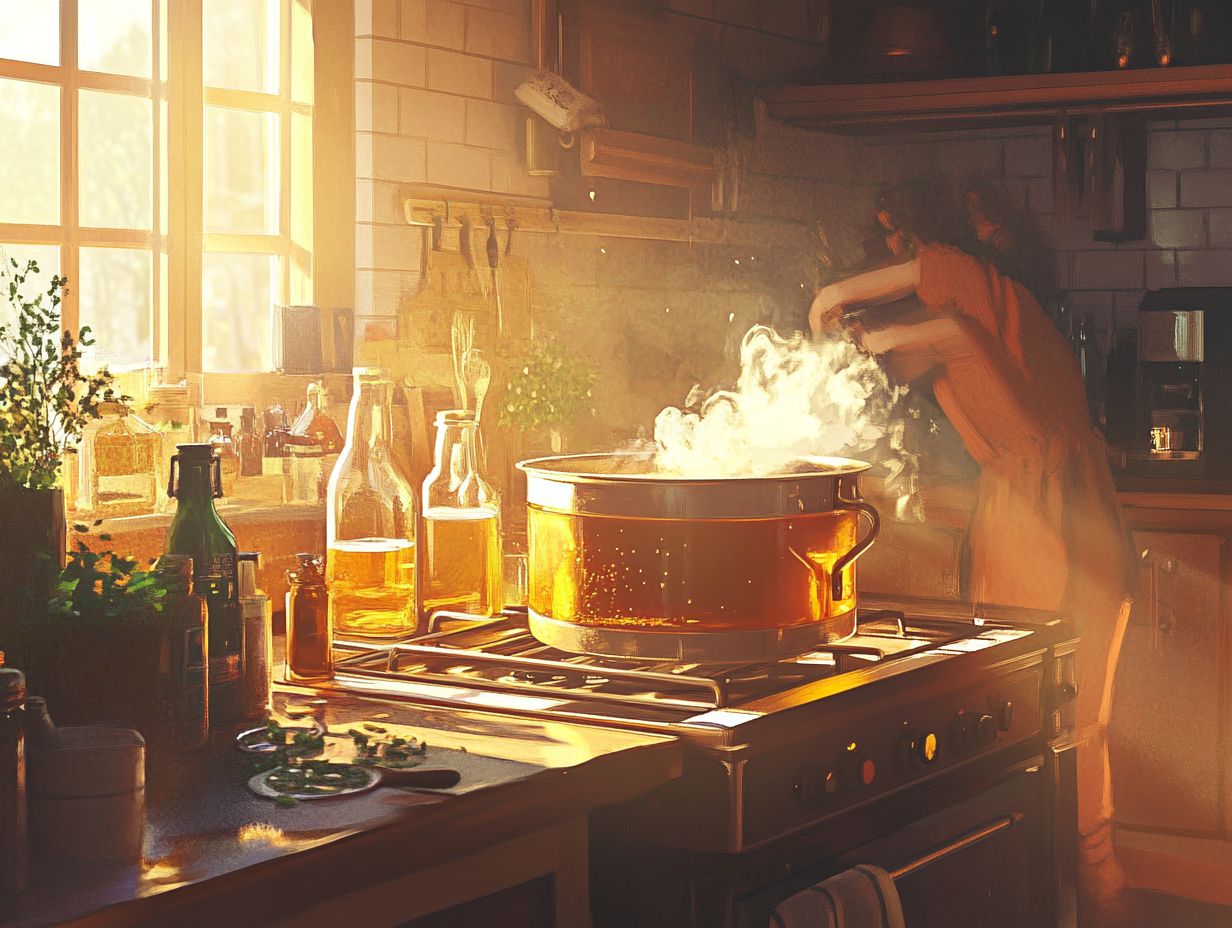
In the rich history of beer production, various ingredients have been used to create distinct flavors and styles. In your brewing journey, consider incorporating a variety of adjuncts and flavorings alongside the main ingredients to craft unique beer styles that elevate the complexity and character of your homebrewed creations. Using adjuncts can help distinguish your beer in homebrew competitions and make your brews stand out.
Imagine using fruits like oranges, berries, and peaches to introduce a refreshing twist, where their sweetness and acidity beautifully complement the malt backbone. Spices such as coriander, cinnamon, and ginger can bring aromatic depth to your brew, evoking seasonal flavors that entice the senses.
Meanwhile, specialty grains like rye or oats can add distinctive textures and subtle taste notes characteristic of certain styles. These adjuncts do more than enhance the flavor profile; they engage in a fascinating dance with yeast during fermentation, leading to unique esters and phenols compounds produced during fermentation that can enhance flavors and aromas that enrich the beer’s aromas.
The harmonious collaboration of these ingredients with traditional brewing components can create a captivating and layered tasting experience, ensuring that each sip is a delightful adventure. Brewing recipes and history offer exciting insights to elevate your craft!
What Are the Steps for Brewing Beer at Home?
Preparation
When brewing beer at home, you embark on a careful and enjoyable process. Each step is crucial, starting with the sanitation of your equipment to ensure everything is pristine. Next, you’ll prepare your ingredients with care, then boil the wort to extract rich flavors.
Fermentation
Following the boil, fermentation takes place, allowing the magic to happen as yeast works its wonders.
Bottling
Finally, you ll bottle and carbonate your brew, with each stage playing a vital role in crafting the quality and flavor profile of your final product. Bottling is a crucial aspect of the brewing process that requires careful attention to detail, especially to meet the standards of homebrew competitions.
1. Sanitizing Equipment
Sanitizing your equipment is an essential first step in the brewing process. It plays a crucial role in preventing unwanted bacteria and contaminants from ruining the fermentation journey and compromising the quality of your beer. This is a critical step in domestic brewing, and neglecting it can result in failed batches and wasted resources.
By ensuring proper sanitation, you guarantee that only the desired yeast strains enter the brew, setting the stage for successful fermentation and, ultimately, delicious beer. To achieve this, you can explore various methods and substances, such as chemical sanitizers like iodophor or Star San, as well as heat-based techniques like boiling or using a dishwasher with a sanitizing cycle.
Neglecting sanitation is a recipe for disaster; you risk off-flavors and infections or even the complete failure of your batch. Thus, mastering and implementing effective sanitation practices is vital for any homebrewer aiming to achieve outstanding results.
2. Prepare the Ingredients for Brewing
Preparing the ingredients is a crucial step in your brewing journey. Measure and mash malted grains, select the perfect hops, and ensure yeast viability.
Each of these elements plays a vital role that significantly impacts the fermentation process and the final flavor profile of your beer. Familiarity with brewing recipes and techniques will enhance your preparation methods and lead to more consistent results.
When mashing those malted grains, it s imperative to control both temperature and time to maximize sugar extraction. A well-executed mash not only enhances the body of your brew but also adds a delightful sweetness.
Selecting the right hops and adding them at specific intervals can create remarkably different aromas and bitterness levels, making timing and variety essential to your craft. Understanding the historical context of brewing can also provide valuable insights into traditional methods and modern innovations.
Properly activating the yeast is equally important. This ensures robust fermentation, which influences the alcohol content and taste of your beer. By prioritizing these preparation methods, you can elevate the consistency and quality of your finished products, bringing your brewing ambitions to life.
Participating in homebrew events can provide opportunities to learn from other brewers and refine your techniques.
3. Mixing and Boiling the Wort
Mixing and boiling the wort are pivotal stages in your brewing journey. These processes facilitate the extraction of rich flavors from the malt and hops while sterilizing the mixture in preparation for fermentation.
During this phase, maintaining precise temperature control is of utmost importance. You ll typically want to heat the wort to around 212 F (100 C) to achieve that rolling boil, which helps dissolve sugars and elevates the overall flavor profile of your beer.
Timing is equally critical; the boil usually lasts between 60 to 90 minutes, with various hop additions at specific intervals to create the desired effects. Early hop additions impart bitterness, effectively balancing the sweetness of the malt, while late additions focus on enhancing aroma and flavor.
This gives you that signature hoppy character that beer enthusiasts adore. Understanding these techniques is essential for you to craft a complex and delightful brew.
4. Fermentation Process
The fermentation process stands as the most transformative phase of brewing. Here, yeast diligently consumes sugars from the wort, producing alcohol and carbon dioxide while simultaneously crafting the distinctive flavors and aromas that define your beer.
Let s break this exciting journey into two main stages: primary and secondary fermentation. During primary fermentation, yeast takes center stage, actively transforming sugars at meticulously controlled temperatures typically between 65 F to 75 F for ales, while lagers prefer a cooler setting.
After a few days, as the vigorous bubbling subsides, the beer transitions into secondary fermentation. At this point, flavors become more refined and sediment settles at the bottom. Maintaining temperature control remains essential, as even the slightest deviation can dramatically influence the final taste, safeguarding against any off-flavors.
Choosing the right fermentation tanks can significantly affect oxygen exposure and, ultimately, the integrity of your brew. Knowledge of alcohol distillation, while not directly applicable to beer, can provide deeper insights into the fermentation process.
5. Bottling and Carbonation

Bottling and carbonation signal the exciting conclusion of the brewing process. You transfer your carefully crafted beer into bottles or kegs, priming it for carbonation. This creates a delicious, ready-to-drink beer that showcases your creativity!
Participating in the homebrewing community can provide insights into the best bottling techniques and practices. To achieve that perfect balance of bubbles and flavors, you ll often turn to priming sugar a simple ingredient that helps yeast produce carbonation in the sealed container. Typically, this sugar is either corn or table sugar, which ferments in the bottle, generating carbon dioxide that dissolves into your beer. This enhances its mouthfeel and delivers the refreshing finish you desire.
Proper sealing methods, like using caps or corks to create an airtight environment, are crucial for maintaining the desired carbonation level. Paying attention to these details elevates the drinking experience and ensures that your final product reflects the quality and care you’ve invested in each batch. Understanding brewing equipment and kits will enhance your homebrewing experience.
Frequently Asked Questions
The homebrewing community is vibrant and supportive, with many resources available to help you get started. From brewing kits to online forums, you can find a wealth of information to guide you through your brewing journey.
Can I brew beer at home legally in the United States?
Yes, it is legal to brew beer at home for personal consumption in all 50 states. The right to brew was reaffirmed by the repeal of Prohibition, specifically the 21st Amendment. However, there may be restrictions on the quantity that can be brewed and the sale of homebrewed beer. Regulations vary by state, so it’s important to be aware of your local rules. Enjoy the brewing journey!
Do I need a license to brew beer at home?
No, a license is not required for homebrewing in the United States as long as it is for personal use and not for sale. Homebrewing laws have been shaped by historical events such as the repeal of Prohibition and the work of advocates like Jimmy Carter and Charlie Papazian. Dive in and start brewing!
Are there any age restrictions for homebrewing?
Yes, homebrewing is typically restricted to adults of legal drinking age, which is 21 years old in the United States. Alcohol laws are strict about who can participate in alcohol production. In some states, like Alabama and Arkansas, individuals 18 years or older may brew beer.
Can I brew any type of beer at home? Understanding beer production limits
Yes, you can brew any type of beer at home as long as it is for personal use. However, some states have restrictions on high-alcohol content beers or may require a separate license for certain types of beer. Be sure to check production limits and state regulations before you start!
Yes, you can share your homebrewed beer with friends and family during social gatherings and homebrew events as long as it is not sold. However, some states may have restrictions on distributing homebrewed beer beyond your immediate circle of friends and family, regulated by alcohol laws and local regulations. Enjoy sharing your creations!
Are There Any Safety Regulations for Homebrewing?
Key Safety Practices
Yes, it’s crucial to clean your brewing tools properly to keep your homebrewed beer safe. Check with your state’s health department for specific regulations and guidelines on alcohol production and homebrewing rights.
Understanding the brewing process and using the right tools, like fermentation tanks, will help you create delicious and safe homebrew!

